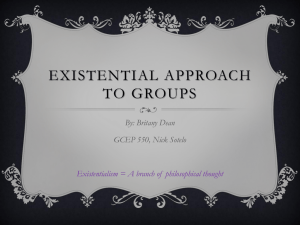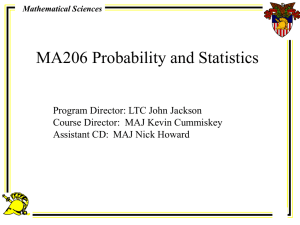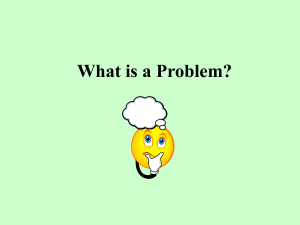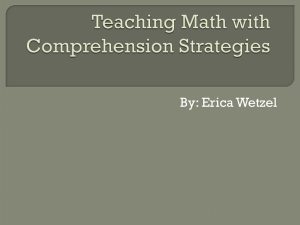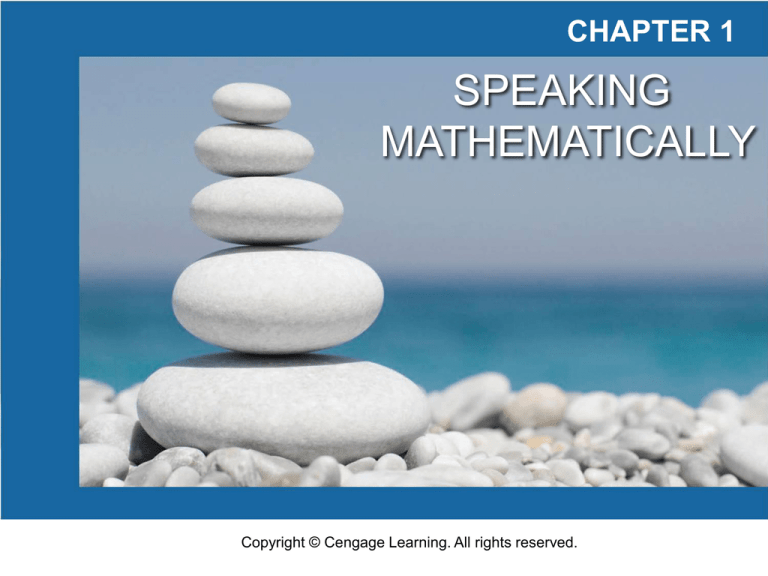
CHAPTER 1
SPEAKING
MATHEMATICALLY
Copyright © Cengage Learning. All rights reserved.
SECTION 1.1
Variables
Copyright © Cengage Learning. All rights reserved.
Variables
There are two uses of a variable. To illustrate the first use,
consider asking
Is there a number with the following property: doubling it
and adding 3 gives the same result as squaring it?
In this sentence you can introduce a variable to replace the
potentially ambiguous word “it”:
Is there a number x with the property that 2x + 3 = x2?
3
Variables
The advantage of using a variable is that it allows you to
give a temporary name to what you are seeking so that you
can perform concrete computations with it to help discover
its possible values.
To illustrate the second use of variables, consider the
statement:
No matter what number might be chosen, if it is greater
than 2, then its square is greater than 4.
4
Variables
In this case introducing a variable to give a temporary
name to the (arbitrary) number you might choose enables
you to maintain the generality of the statement, and
replacing all instances of the word “it” by the name of the
variable ensures that possible ambiguity is avoided:
No matter what number n might be chosen, if n is greater
than 2, then n2 is greater than 4.
5
Example 1 – Writing Sentences Using Variables
Use variables to rewrite the following sentences more
formally.
a. Are there numbers with the property that the sum of their
squares equals the square of their sum?
b. Given any real number, its square is nonnegative.
Solution:
a. Are there numbers a and b with the property that
a2 + b2 = (a + b)2?
Or: Are there numbers a and b such that a2 + b2 = (a + b)2?
6
Example 1 – Solution
cont’d
Or: Do there exist any numbers a and b such that
a2 + b2 = (a + b)2?
b. Given any real number r, r2 is nonnegative.
Or: For any real number r, r2 0.
Or: For all real numbers r, r2 0.
7
Some Important Kinds of
Mathematical Statements
8
Some Important Kinds of Mathematical Statements
Three of the most important kinds of sentences in
mathematics are universal statements, conditional
statements, and existential statements:
9
Some Important Kinds of Mathematical Statements
Universal Condition Statements
Universal statements contain some variation of the words
“for all” and conditional statements contain versions of the
words “if-then.”
10
Some Important Kinds of Mathematical Statements
A universal conditional statement is a statement that is
both universal and conditional. Here is an example:
For all animals a, if a is a dog, then a is a mammal.
One of the most important facts about universal conditional
statements is that they can be rewritten in ways that make
them appear to be purely universal or purely conditional.
11
Example 2 – Rewriting an Universal Conditional Statement
Fill in the blanks to rewrite the following statement:
For all real numbers x, if x is nonzero then x2 is positive.
a. If a real number is nonzero, then its square _____.
b. For all nonzero real numbers x, ____.
c. If x ____, then ____.
d. The square of any nonzero real number is ____.
e. All nonzero real numbers have ____.
12
Example 2 – Solution
a. is positive
b. x2 is positive
c. is a nonzero real number; x2 is positive
d. Positive
e. positive squares (or: squares that are positive)
13
Some Important Kinds of Mathematical Statements
Universal Existential Statements
A universal existential statement is a statement that is
universal because its first part says that a certain property
is true for all objects of a given type, and it is existential
because its second part asserts the existence of
something. For example:
Every real number has an additive inverse.
In this statement the property “has an additive inverse”
applies universally to all real numbers.
14
Some Important Kinds of Mathematical Statements
“Has an additive inverse” asserts the existence of
something—an additive inverse—for each real number.
However, the nature of the additive inverse depends on the
real number; different real numbers have different additive
inverses.
15
Example 3 – Rewriting an Universal Existential Statement
Fill in the blanks to rewrite the following statement:
Every pot has a lid.
a. All pots _____.
b. For all pots P, there is ____.
c. For all pots P, there is a lid L such that _____.
Solution:
a. have lids
b. a lid for P
c. L is a lid for P
16
Some Important Kinds of Mathematical Statements
Existential Universal Statements
An existential universal statement is a statement that is
existential because its first part asserts that a certain object
exists and is universal because its second part says that
the object satisfies a certain property for all things of a
certain kind.
17
Some Important Kinds of Mathematical Statements
For example:
There is a positive integer that is less than or equal to
every positive integer:
This statement is true because the number one is a
positive integer, and it satisfies the property of being less
than or equal to every positive integer.
18
Example 4 – Rewriting an Existential Universal Statement
Fill in the blanks to rewrite the following statement in three
different ways:
There is a person in my class who is at least as old as
every person in my class.
a. Some _____ is at least as old as _____.
b. There is a person p in my class such that p is _____.
c. There is a person p in my class with the property that for
every person q in my class, p is _____.
19
Example 4 – Solution
a. person in my class; every person in my class
b. at least as old as every person in my class
c. at least as old as q
20
Some Important Kinds of Mathematical Statements
Some of the most important mathematical concepts, such
as the definition of limit of a sequence, can only be defined
using phrases that are universal, existential, and
conditional, and they require the use of all three phrases
“for all,” “there is,” and “if-then.”
21
Some Important Kinds of Mathematical Statements
For example, if a1, a2, a3, . . . is a sequence of real numbers,
saying that
the limit of an as n approaches infinity is L
means that
for all positive real numbers ε, there is an integer N such that
for all integers n, if n > N then –ε < an – L < ε.
22

